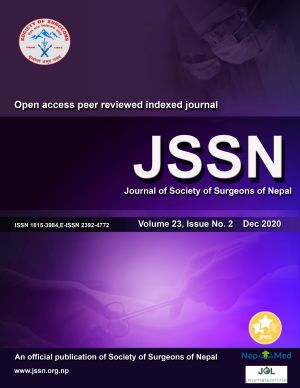Combination of three-dimensional reconstruction technique and blood parameters for the evaluation of tumor burden and prognosis in patients with hepatocellular carcinoma undergoing liver resection
DOI:
https://doi.org/10.3126/jssn.v23i2.35799Keywords:
Hepatic resection, 3D reconstruction technique, HCC, IQQAAbstract
Introduction: Hepatic resection is the mainstay of treatment for Hepatocellular carcinoma (HCC). Three- dimensional technique helps to create an image of the liver using pre-operative computed tomography (CT) scans which can be used for planning of surgery and counselling of the patient. Various lab parameters have also been shown to affect the prognosis of HCC. This study was designed to analyse whether three dimensional technique and blood parameters are correlated with the prognosis among HCC patients following hepatic resection and also to find a relation between these variables.
Methods: Data were collected retrospectively to recruit HCC patients treated between January 2010 and December 2016. Seventy-three HCC patients without extrahepatic metastasis, who underwent hepatic resection and had pre-operative CT scan done in our centre were enrolled for this study. IQQA® was used to create a three-dimensional imaging, and various related laboratory parameters were also collected. Outcomes of these patients were calculated to establish a relationship between IQQA, laboratory results and the prognosis of the patients.
Results: The one, three and five year overall survival (OS) rates were 94.4%, 53.3% and 19.4% respectively, and disease-free survival (DFS) rates were 75%, 31.3% and 12.8% respectively. IQQA percentage of tumor was statistically significant for both OS and DFS. In the multivariate analysis, patients having lymph node metastasis, vascular invasion and high pre-op CA 19-9 had lower DFS rate, while it increased in those with high pre-op albumin. Other significant variables for OS were lymph node metastasis, Child Pugh score, high pre-op alpha fetoprotein (AFP) value and high CA 19-9. Resected segments, lymph node metastasis, liver cirrhosis, blood loss and hospital stay were significant between the two IQQA subgroups (IQQA?30% and IQQA>30%). Additionally in these IQQA subgroups, significant difference was found between DFS and OS.
Conclusion: IQQA software is helpful to create a 3D image of the liver, and can be combined with lab parameters to predict prognosis for patients with liver cancer. Therefore, this three-dimensional imaging technique can be used as a routine technique for patients undergoing liver resection.




